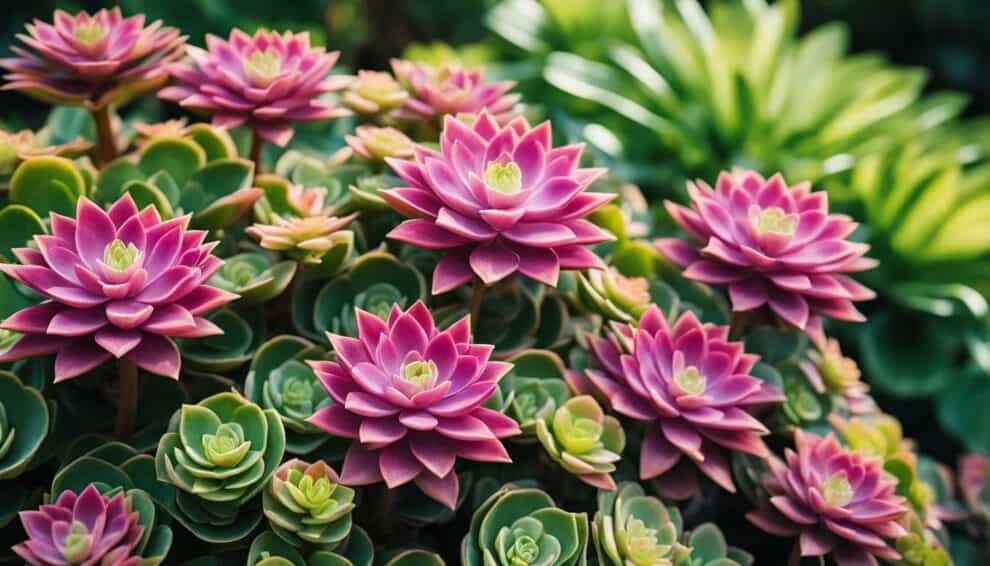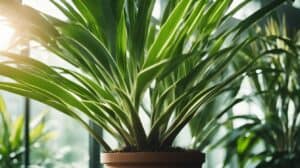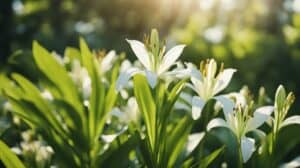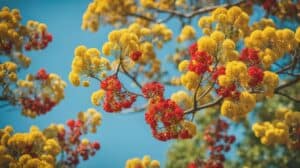Aeonium ‘Kiwi’ is a succulent plant that is known for its vibrant and colorful foliage.
It is a popular choice among gardeners who want to add a touch of color to their garden.
However, caring for this plant can be a bit tricky, especially for those who are new to gardening or are not familiar with succulent care.

In this article, we will provide some tips and tricks for caring for Aeonium ‘Kiwi’ to ensure that it thrives in your garden.
We will cover topics such as sunlight, soil, watering, and propagation.
Whether you are a seasoned gardener or a beginner, these tips will help you create a beautiful and healthy Aeonium ‘Kiwi’ garden.
So, let’s get started!
Understanding Aeonium ‘Kiwi’
Species Overview
Aeonium ‘Kiwi’ is a beautiful succulent plant that belongs to the Crassulaceae family.
It is a hybrid of Aeonium decorum and Aeonium undulatum, and it is native to the Canary Islands.
The plant has become popular among gardeners and succulent enthusiasts due to its colorful and attractive appearance.
Distinctive Features
Aeonium ‘Kiwi’ has a rosette-shaped growth habit with leaves that are green, yellow, pink, and cream-colored.
The leaves are spoon-shaped, fleshy, and have a waxy texture. The plant can grow up to 12 inches tall and 18 inches wide.
It produces small yellow flowers in the summer, which attract bees and other pollinators.
One of the unique features of Aeonium ‘Kiwi’ is that its coloration changes with the seasons and the amount of sunlight it receives.
In the winter, the leaves become more green, while in the summer, they turn pink and yellow.
The plant requires full sun to partial shade to maintain its vibrant colors.
Aeonium ‘Kiwi’ is a low-maintenance plant that is easy to care for.
It prefers well-draining soil and should be watered sparingly, as overwatering can cause root rot.
The plant can be propagated by stem cuttings or by removing offsets from the base of the plant.
Overall, Aeonium ‘Kiwi’ is a beautiful and unique succulent plant that can add color and interest to any garden or indoor space.
With proper care and attention, it can thrive and provide enjoyment for years to come.
Essential Care Guidelines

Lighting Requirements
Kiwi Aeoniums require bright, indirect sunlight to thrive. They should be placed in a location where they receive at least 6 hours of sunlight per day.
However, direct sunlight can scorch their leaves, so it’s important to provide some shading during the hottest part of the day.
If you’re growing your Kiwi Aeonium indoors, place it near a south-facing window or under grow lights.
Watering Schedule
Kiwi Aeoniums prefer to be kept on the drier side, so it’s important not to overwater them.
Allow the soil to dry out completely between watering, and then water deeply until the excess water drains out of the bottom of the pot.
During the winter months, when the plant is dormant, water sparingly.
Soil and Fertilization
Kiwi Aeoniums prefer well-draining soil that’s rich in organic matter. A mix of cactus soil and perlite works well.
Fertilize your Kiwi Aeonium once a month during the growing season with a balanced, water-soluble fertilizer.
Be sure to dilute the fertilizer to half strength to avoid burning the plant.
Temperature and Humidity
Kiwi Aeoniums prefer temperatures between 60-75°F (15-24°C). They can tolerate slightly cooler temperatures during the winter months.
They also prefer low to moderate humidity levels, so avoid placing them in a humid environment.
If you live in a dry climate, consider placing a tray of water near the plant to increase humidity.
Propagation Techniques

Aeonium ‘Kiwi’ is a popular succulent plant that can be propagated easily through cuttings, seeds, and offsets.
Here are some tips on how to propagate Aeonium ‘Kiwi’ successfully.
Cuttings
Taking cuttings is the easiest and most common way to propagate Aeonium ‘Kiwi’. Follow these steps to propagate your plant through cuttings:
- Choose a healthy stem that is at least 3 inches long.
- Cut the stem with a sharp, sterile knife or scissors.
- Allow the cutting to air dry for a few days until the cut end calluses over.
- Plant the cutting in a well-draining soil mix and water lightly.
- Keep the soil moist but not waterlogged and place the cutting in a bright, indirect light.
- The cutting should root within a few weeks.
Seeds
Propagating Aeonium ‘Kiwi’ from seeds is a bit more challenging but can be rewarding.
Here are some tips on how to propagate your plant through seeds:
- Collect the seeds from a mature Aeonium ‘Kiwi’ plant.
- Sow the seeds in a well-draining soil mix and cover lightly with soil.
- Keep the soil moist but not waterlogged and place the container in a bright, indirect light.
- The seeds should germinate within a few weeks.
- Once the seedlings have grown a few leaves, transplant them into individual pots.
Offsets
Offsets are small plantlets that grow from the base of the parent plant. Propagating Aeonium ‘Kiwi’ from offsets is easy. Here are some tips:
- Wait until the offsets are at least 1/3 the size of the parent plant before removing them.
- Gently pull the offset away from the parent plant and allow the cut end to callus over for a few days.
- Plant the offset in a well-draining soil mix and water lightly.
- Keep the soil moist but not waterlogged and place the offset in a bright, indirect light.
- The offset should root within a few weeks.
Common Issues and Solutions

Pest Management
Kiwi Aeoniums are generally hardy plants, but they can still fall prey to pests.
Common pests that may attack your Kiwi Aeonium include spider mites, mealybugs, and scale insects.
These pests can cause damage to the leaves and stem of the plant, leading to discoloration and stunted growth.
To manage pest infestations, it is recommended to use natural methods such as spraying the plant with a mixture of water and neem oil or insecticidal soap.
You can also manually remove the pests using a soft brush or cotton swab dipped in rubbing alcohol.
Disease Prevention
Kiwi Aeoniums can be susceptible to fungal diseases such as root rot, powdery mildew, and black spot.
These diseases can be caused by overwatering, poor drainage, or high humidity levels.
To prevent fungal diseases, ensure that the plant is not overwatered and has good drainage.
Avoid getting water on the leaves and stem of the plant, as this can create a humid environment that promotes fungal growth.
If you notice any signs of disease, such as yellowing or wilting leaves, remove the affected parts of the plant and treat with a fungicide.
Handling Stress and Damage
Kiwi Aeoniums can become stressed or damaged due to factors such as extreme temperatures, drought, or physical damage.
Signs of stress or damage may include wilting, discoloration, or leaf drop.
To help your Kiwi Aeonium recover from stress or damage, ensure that it is placed in a suitable environment with the right amount of light, temperature, and humidity.
Water the plant regularly, but avoid overwatering.
If the plant has suffered physical damage, such as broken leaves or stem, remove the damaged parts and treat with a fungicide or insecticide if necessary.
Frequently Asked Questions

What are the best practices for watering an Aeonium ‘Kiwi’?
Aeonium ‘Kiwi’ plants prefer well-draining soil and should be watered thoroughly but infrequently.
It is important to allow the soil to dry out between watering sessions to prevent root rot.
During winter, when the plant is dormant, watering should be reduced.
How can I propagate my Aeonium ‘Kiwi’ successfully?
Aeonium ‘Kiwi’ can be propagated through stem cuttings. Cut a stem section that is at least 3 inches long and allow it to dry for a day or two.
Then, plant the cutting in well-draining soil and keep it in a bright, indirect light until it roots.
What should I do if my Aeonium ‘Kiwi’ starts to become leggy?
If your Aeonium ‘Kiwi’ starts to become leggy, it is a sign that it is not receiving enough light.
Move the plant to a brighter location or provide it with supplemental lighting. Additionally, you can prune the leggy stems to encourage new growth.
What are the light requirements for a healthy Aeonium ‘Kiwi’?
Aeonium ‘Kiwi’ plants require bright, indirect light to thrive.
They can tolerate some direct sunlight, but too much can cause the leaves to burn.
If grown indoors, place the plant near a south-facing window or provide it with artificial lighting.
How do I prevent leaves from falling off my Aeonium ‘Kiwi’?
Leaves falling off an Aeonium ‘Kiwi’ can be a sign of overwatering or underwatering.
Make sure to water the plant thoroughly but infrequently, allowing the soil to dry out between watering sessions.
Additionally, avoid touching or moving the plant too much, as this can cause the leaves to fall off.
Can Aeonium ‘Kiwi’ be grown indoors, and if so, how?
Aeonium ‘Kiwi’ can be grown indoors as long as it is provided with bright, indirect light.
Place the plant near a south-facing window or provide it with artificial lighting.
Additionally, make sure to water the plant thoroughly but infrequently and provide it with well-draining soil.














